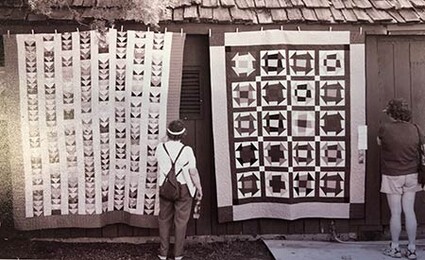Quilting has a long and vibrant international history
Last updated 7/7/2020 at Noon

courtesy Sisters Outdoor Quilt Show
Those who visit the Sisters Outdoor Quilt Show have been, and continue to be, inspired and awed by the works of textile art.
The technique we call quilting crossed many borders and played a part in ancient history. From the beginning, quilts have told human stories, reflected religious and philosophical beliefs, and revealed what people wore, either out of necessity or as adornment.
Stitched into layered linen with cotton stuffing inserted to raise sections of the design, faces of those who lived thousands of years ago look beyond the edges of quilts into a future they’d find hard to believe.
Researchers have uncovered examples of quilting around the world. In North America, quilting began with immigrants bringing their sewing and handwork traditions from Europe.
For hundreds of years, African American slaves made quilts for their owners and for themselves. When time allowed, women pieced together beautiful quilts with the scraps they gathered and saved. The result was a beauty that defied circumstances of servitude and focused on love stitched together in terrible times. That tradition has evolved and thrived through the skilled hands of people like the women of Gee’s Bend, Alabama. Sisters Outdoor Quilt Show was honored to have them as guests in years past to pass along their wisdom — both with the needle and in beautiful a capella song.
The Smithsonian National Museum of the American Indian has one of the largest collections of Native American quilts from the 1940s. The Northern Plains tribes began quilting out of necessity when buffalo herds were decimated by Euro-American settlers attempting to subdue the Plains tribes in the 19th century. The tribes had to find alternate sources for robes and ritual practices. Missionary wives taught quilting techniques to Indian women, who soon found imaginative ways to personalize what they created.
The origins of quilting can be traced back to ancient Egypt. Quilting commemorated personal stories, historical events and was a reflection of the beauty surrounding its maker. There are rare examples of old quilts. One preserved quilt is a Sicilian wall hanging made in the 14th century. It is estimated to have been made about 1395. It portrays the legend of Tristan. The piece of art was made using quilting with trapunto (stuffed quilting) on solid white fabric.
The piece is now displayed in the Victoria and Albert Museum in London, England.
Some researchers believe that quilting, in the form of quilted clothing, was brought to Europe through the Crusades. Muslim warriors wore tightly quilted garments as part of their armor, which was soon adopted by medieval European soldiers.
Although fine quilting was a sign of affluence, the sewing together of layers for warmth was done by the poor as well. If makers couldn’t afford carded wool or cotton to sew between layers, then old blankets, clothing or even feathers, straw or leaves were used instead.
The oldest discovery, from 5,500 years ago is of an ivory carving, featuring the king or Pharaoh of the Egyptian First Dynasty wearing a mantle or cloak that appears to be quilted. It was found in the Temple of Osiris at Abydos in 1903 and is currently in the British Museum collection.
The Textile Society of America at [email protected] of Nebraska – Lincoln, offers interesting and informative research into the relationship between historical Chinese patchwork garments, known as the baijia pao or “One Hundred Families Robe,” and a recent practice of American adopters of Chinese children. By combining the Chinese tradition of baijia pao, with American commemorative quilt making, makers of the new “One Hundred Good Wishes Quilts” are creating a unique opportunity for a cross-cultural exchange.
People started making Chinese patchwork in the Liu Song of the Southern Dynasty. The first emperor of Liu Song Dynasty, named Liu Yu, was born in an underprivileged family. His mother gathered rags from the neighborhoods to make a patchwork. When he became the emperor, he perceived this kind of patchwork as the symbol for his impoverished childhood. All the infants in Liu’s family had to use the patchwork so that his offspring could know how fortunate they were. Afterwards, his citizens followed this royal custom to make “Bai jia yi” for their babies.
For centuries the Chinese used quilted cloth to make padded winter clothing, wisely reasoning that two or three layers were warmer than one. Later, the Arabs were discovered wearing quilted garments beneath chain mail. Multiple layers of cloth sewn together provided additional protection and prevented chafing more effectively than cloth of a single layer. Some historians believe this quilted clothing, when brought back to Europe, provided the idea for the bed quilt used today.
The 2021 SOQS will feature Egyptian tentmakers who do hand-applique that originated in the Bedouin tribes. According to SOQS Executive Director Dawn Boyd, the men applique the designs that are used for weddings and other celebrations.
“We had to put off their visit until next year, we want to celebrate world-quilting stories,” Boyd said.
“These men pass down their traditions and we are excited to share them with everyone.”
















Reader Comments(0)